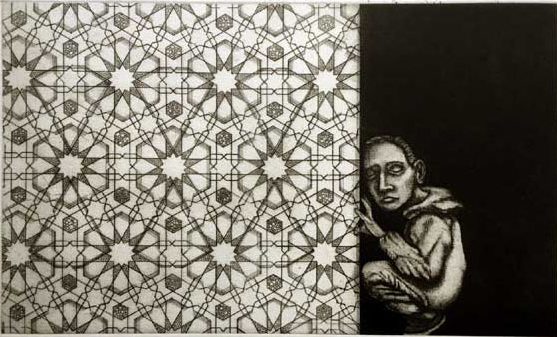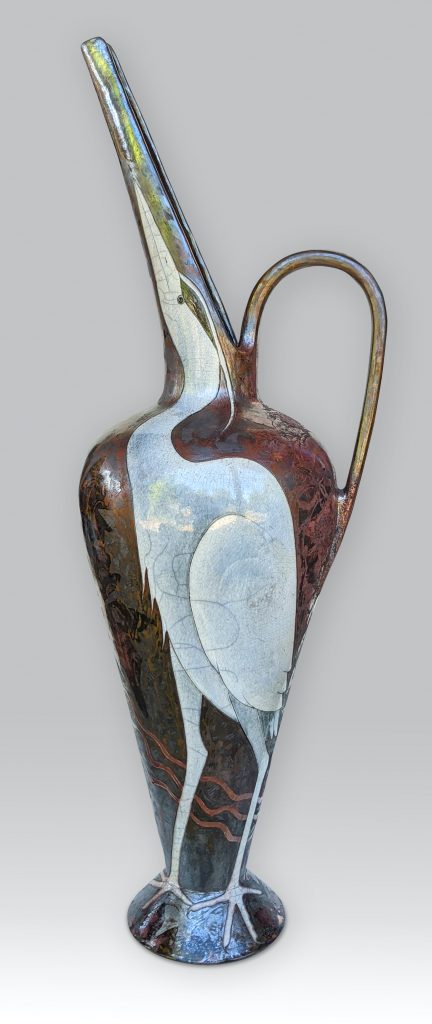By Alec Clayton
For half a century, Childhood’s End Gallery has been Olympia’s paramount art gallery. Bill and Richenda Richardson opened the gallery and gift shop in 1971. Since then, they’ve introduced many of the region’s best painters, sculptors and craftspersons to our town. Today, they continue to display works, not only by outstanding local artists, but by hundreds of artists and artisans from all over the country. The Richardsons’ selection of items includes functional and decorative work in a variety of media including art glass, ceramics, woodwork, metalwork, jewelry and a wide range of fine art and reproductions.
Childhood’s End celebrates its 50th anniversary with two exhibitions of the works of just a few of the area’s leading artists who’ve graced the gallery over this past half century. It’s an eclectic selection, including ceramic sculpture, furniture, and paintings and prints in many media. Following is a sampling of some of its highlights.

Lisa Sweet shows a group of three small etchings, each with stark contrasts between dark and light areas with a subtly detailed drawing in each area. “Listens II,” for instance, is a drawing of a figure squatting down in a solid, black space, his faced pressed against a wall as if listening in to what’s going on inside. The wall, which constitutes the larger two thirds of the space, is an elaborate wallpaper-like design in flat, black-and-white patterns. Sweet’s “Ex Voto for 2020: Starry Night” is a mysterious window into a black, star-filled void. There’s a quality of magic about these pictures.
Nikki McClure’s 30-by-40-inch paper cut “Map of Community” is a delightfully playful picture map of a city with birds flying overhead. One can easily get swept up in the details.
Chris Maynard is famous for his skillfully executed pictures, which are made by cutting shapes of birds, fish and other creatures out of and into feathers. They’re a brilliant interplay of positive and negative space. He has two pieces in the show, with many more in the adjacent gift shop.

Christopher Mathie shows a large, dramatic, mixed-media painting of what appears to be a mythological birdman. The bird’s head is that of a bald eagle, but below its body are the legs and genitals of a human male in tones of black, white and gray on a ground of the most fiery red. In the background is a group of ominous looking figures, painted in Mathie’s de Kooning-esque manner.
One of the more imposing works in the show is a large, elegantly shaped stoneware jar by Boni and Dave Deal, titled “Egret Ewer.” It sits on the floor in a corner of a gallery. Kiln-fired onto the surface of the jar is a picture of an egret. The shape of the jar mirrors the shape of the egret, with a slender, curvaceous neck. Barely recognizably, whether intentional or a happy coincidence, the bird’s wing creates an elongated, human face.

Amy Fisher does astonishing things with shallow space and shifting perspectives in her watercolor collage “Shifting Ground III.” It’s thoroughly abstract but captures the look and feel of grass, dirt and trees.
Tarran Shlenar’s oil on canvas, “Clinging Vines,” presents a disturbing vision of interwoven vines that are actually violently distorted human bodies. There’s a shouting face almost lost in the slashes of paint. Pink bodies are engaged in battle in a forest. Amazingly similar to Shelenar’s painting are a series of three small oil paintings by Ryan Weatherly, called “Serial Angles.” The imagery and painting style are so much the same that without seeing the wall label, one would surely think they were by the same artist. The only difference seems to be the color. Weatherly’s paintings are in the blues and greens of forest and sky, whereas Shelenar’s reds and pinks evoke blood and gore.
Dan Barnett’s stoneware, “Totem with Fish,” is also quite impressive — a combination of surrealism with Northwest Native-style totem poles. Finally, worth noting are Ron Hinton’s etched bronze sculptures, which bear a variety of surface markings. They’re like abstract origami, but with the solidity of bronze.
WHAT
50th-Anniversary Exhibition, Part 2
WHEN
10 a.m. – 6 p.m. Mondays – Saturdays;
11 a.m. – 5 p.m. Sundays through Dec. 31
WHERE
Childhood’s End Gallery,
222 Fourth Ave. W, Olympia
HOW MUCH
Free (artworks for sale as marked)
LEARN MORE
360-943-3724
